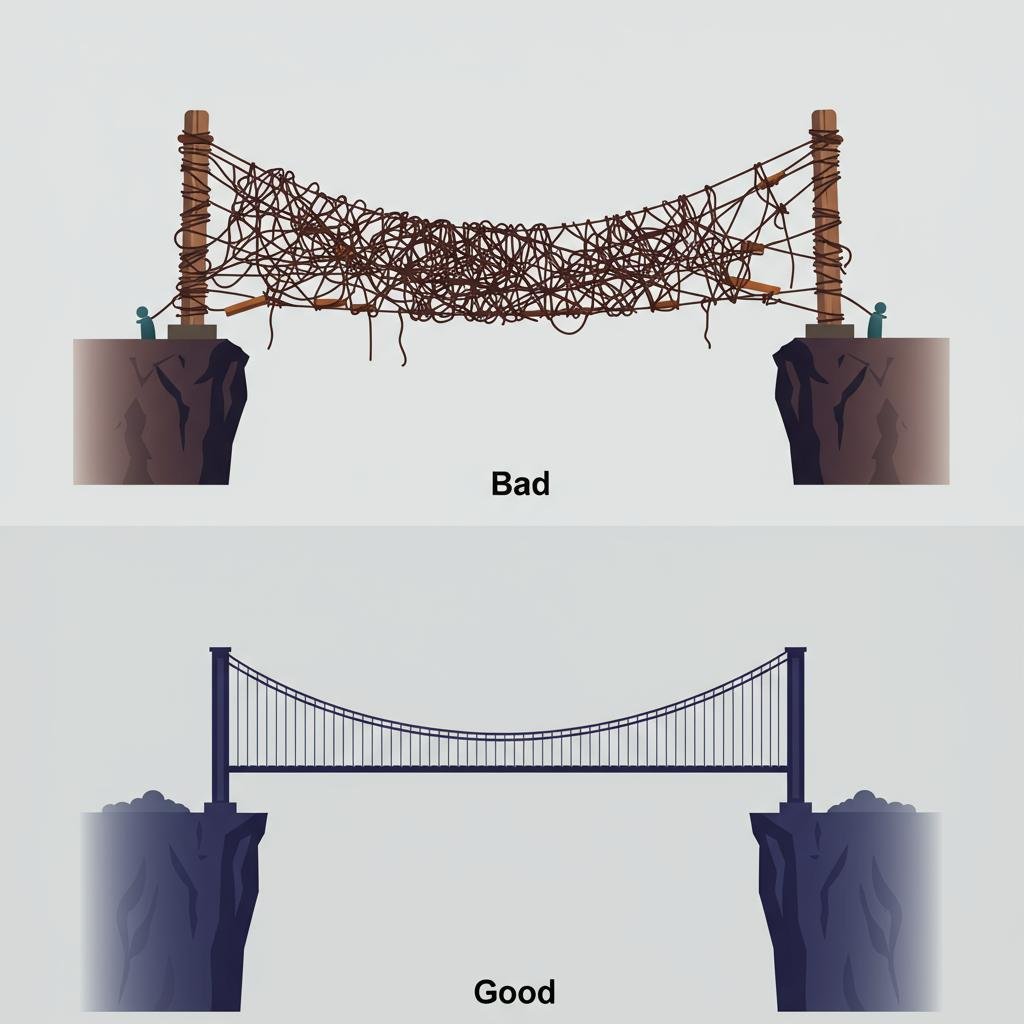The Hidden Costs of 'Good Enough' Solutions
July 5, 2025

Many businesses choose quick, cheap solutions, only to face spiraling long-term expenses. This article uncovers the hidden costs of ‘good enough’ software in maintenance, scalability, and integration, demonstrating why a strategic investment in a robust, production-ready foundation is crucial for sustainable growth.
When ‘Fast and Cheap’ Becomes ‘Slow and Expensive’
In the race to launch, the allure of a ‘Minimum Viable Product’ (MVP) can be powerful. The promise is to get to market quickly, on a tight budget, and iterate later. But what happens when ’later’ arrives, and the quick-fix solution starts to crack under the pressure of real-world use?
This is the ‘good enough’ trap: a short-term win that creates long-term debt. What seems like a savvy financial decision upfront often morphs into a continuous drain on resources, stifling growth and innovation. The initial savings are quickly eclipsed by mounting maintenance costs, performance bottlenecks, and the eventual, painful realization that a complete rebuild is necessary.
This post is for leaders who look beyond the initial price tag to the total cost of ownership. We will dissect the true, often hidden, costs of settling for mediocrity and make the case for investing in a solid architectural foundation from day one—a foundation built for scale, reliability, and long-term business success.
Section 1: The Quicksand of Technical Debt and Maintenance
‘Good enough’ solutions are often built with shortcuts, leading to brittle, poorly documented code. This accumulation of compromises is known as technical debt. The immediate consequence is that every new feature or bug fix takes exponentially longer to implement. Onboarding new engineers becomes a nightmare as they struggle to understand the system, and your most senior developers get stuck untangling spaghetti code instead of driving innovation.
Investing in a clean, well-architected backend is not a luxury; it’s a strategic necessity. A system built with robust technologies like Go or Rust, following best practices, is easier to maintain, debug, and extend. This drastically reduces long-term operational costs. At Azlo.pro, we don’t just write code; we build maintainable assets. Our focus on clean architecture means your system remains agile and your team stays productive for years to come.
Section 2: Hitting the Scalability Cliff at Full Speed
An MVP is typically designed for a handful of users, not for resounding success. When your user base or data volume grows unexpectedly, the ‘good enough’ system inevitably fails. Performance plummets, users experience crashes and slowdowns, and your brand reputation suffers irreparable damage. This forces you into expensive, reactive patches or a panic-driven migration right when your business should be capitalizing on growth.

True scalability is designed in, not bolted on as an afterthought. This involves choosing the right technologies from the start—like Go for high concurrency or Rust for performance-critical tasks—and architecting for horizontal scaling from the outset. At Azlo.pro, we anticipate your growth. By building with scalable technologies and cloud-native principles, we ensure your backend can handle success without requiring a costly, emergency rewrite.
Section 3: The Dead End of Poor Integration and Automation
Inexpensive solutions often neglect proper API design. They become isolated data silos that are difficult, if not impossible, to connect with other critical business systems. As a result, you can’t automate essential workflows, integrate with valuable third-party tools, or leverage emerging AI technologies. Your business loses efficiency and the ability to innovate, quickly falling behind more agile competitors.

A production-ready system must have a clean, well-documented, and flexible API. This transforms your backend from a simple application into a powerful platform that can be extended and integrated, unlocking value across your entire organization. We build systems designed to connect. Our expertise in creating robust APIs is the key to unlocking custom automation and AI integrations that solve tangible business problems and create a sustainable competitive edge.
Section 4: Beyond the Invoice: Calculating the Total Cost of Ownership (TCO)
Focusing only on the initial development cost provides a dangerously incomplete picture of the real investment. Business leaders are often blindsided by the true costs that emerge over time. These include countless developer hours spent on maintenance, lost revenue from downtime, missed opportunities due to a lack of features, and the eventual, monumental cost of a complete rebuild.
To make an informed decision, you must adopt a Total Cost of Ownership (TCO) mindset. The formula is simple: TCO = Initial Build Cost + Ongoing Maintenance Costs + Opportunity Costs + Rework Costs. A higher upfront investment in a quality system dramatically lowers the other variables, resulting in a much lower TCO over the life of the application. Partnering with Azlo.pro means investing in a lower TCO. We deliver a robust, scalable, and maintainable solution that provides a higher long-term return on investment than any ‘good enough’ alternative.
The ‘good enough’ solution is a siren song, luring businesses with the promise of speed and low initial cost, only to reveal its true price in the form of technical debt, scaling failures, and strategic dead ends. The most successful companies understand that their technology is not a cost center, but a strategic asset.
By prioritizing a robust, well-engineered foundation, you are not just avoiding future problems; you are building a platform for sustainable growth, innovation, and long-term profitability. It’s the difference between building on sand and building on bedrock.
If you’re ready to move beyond ‘good enough’ and build a truly robust system designed for the future, contact Azlo.pro to discuss your project.